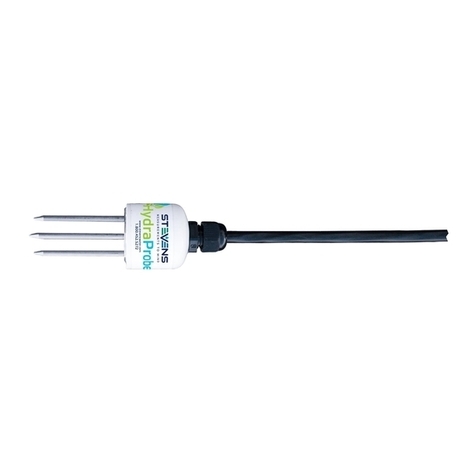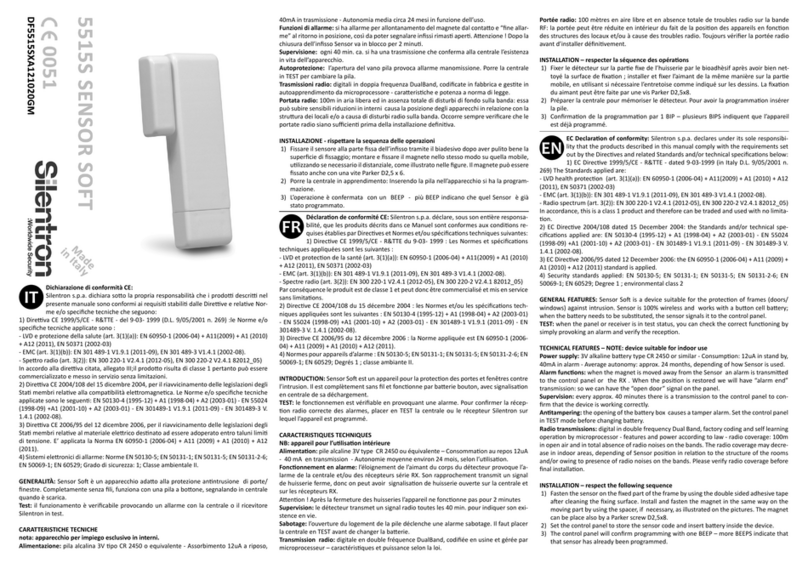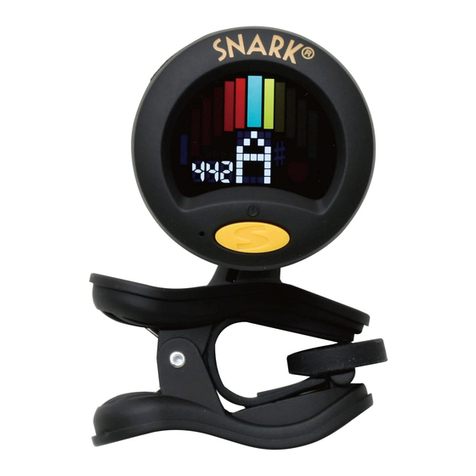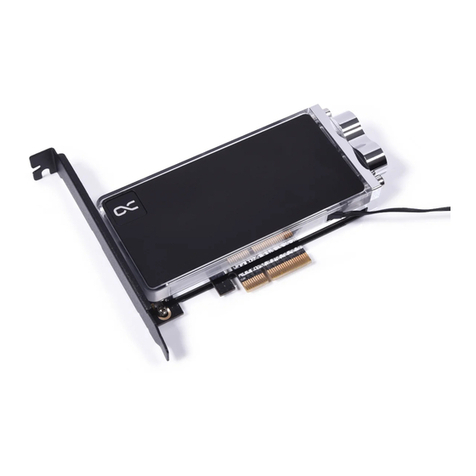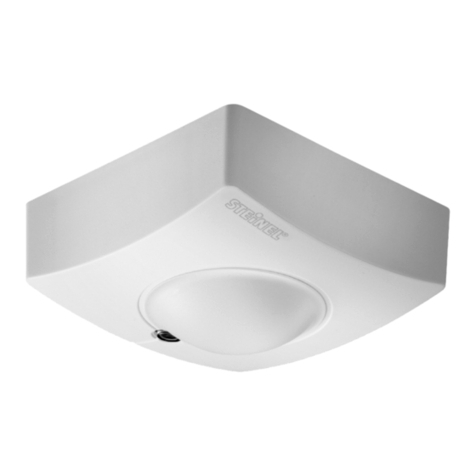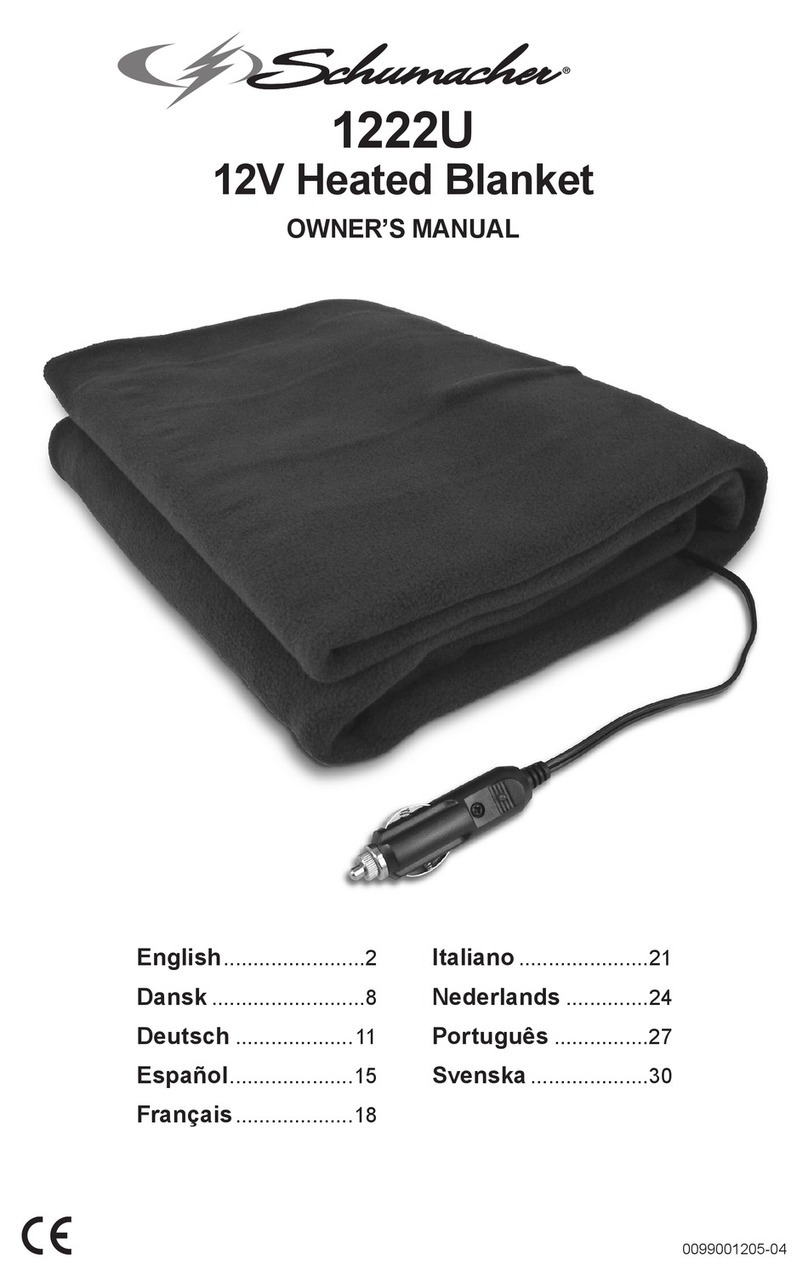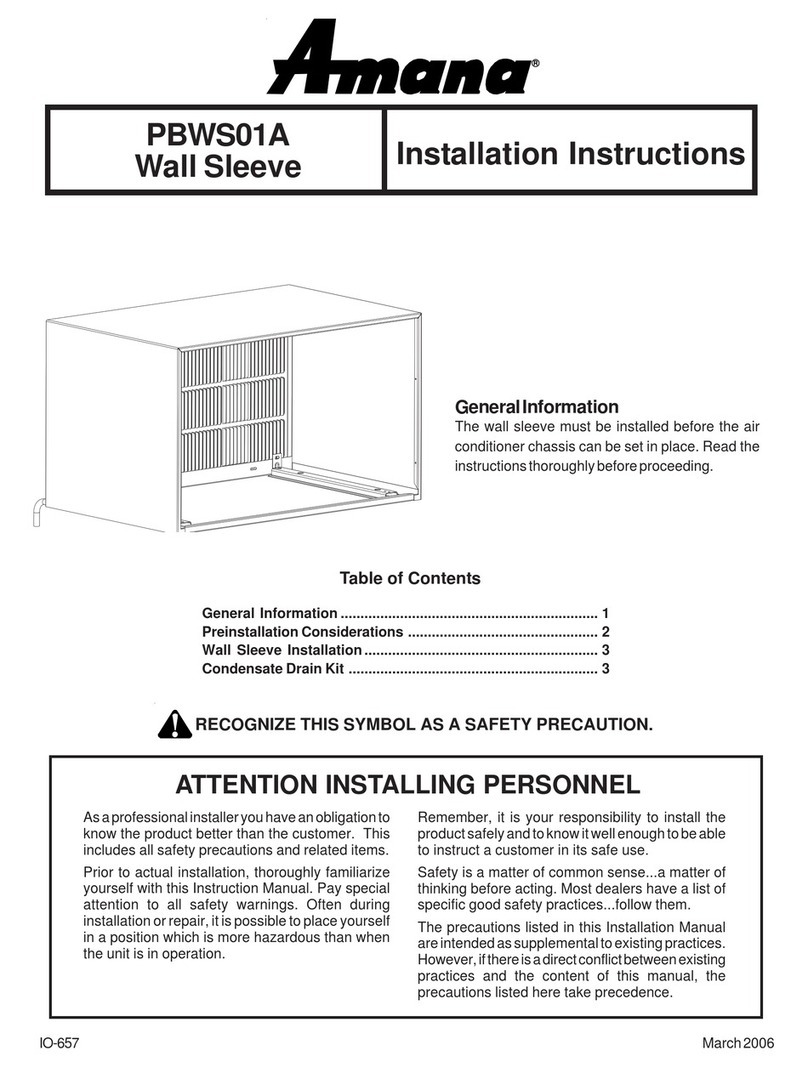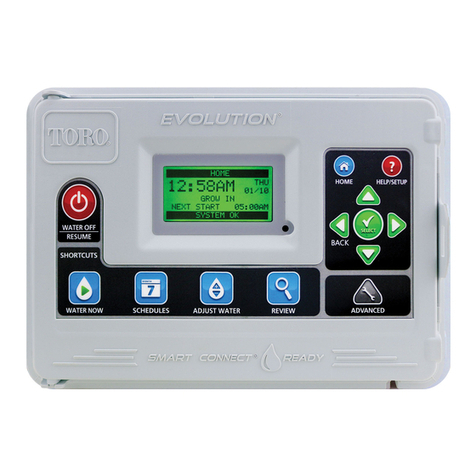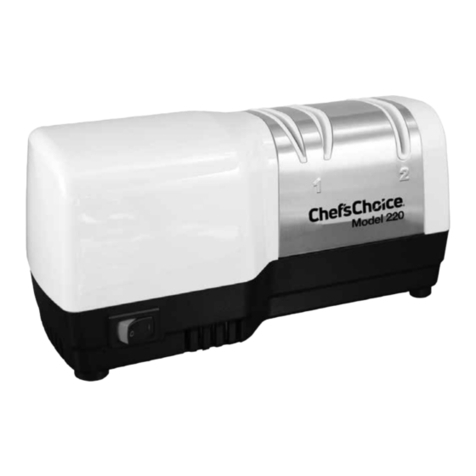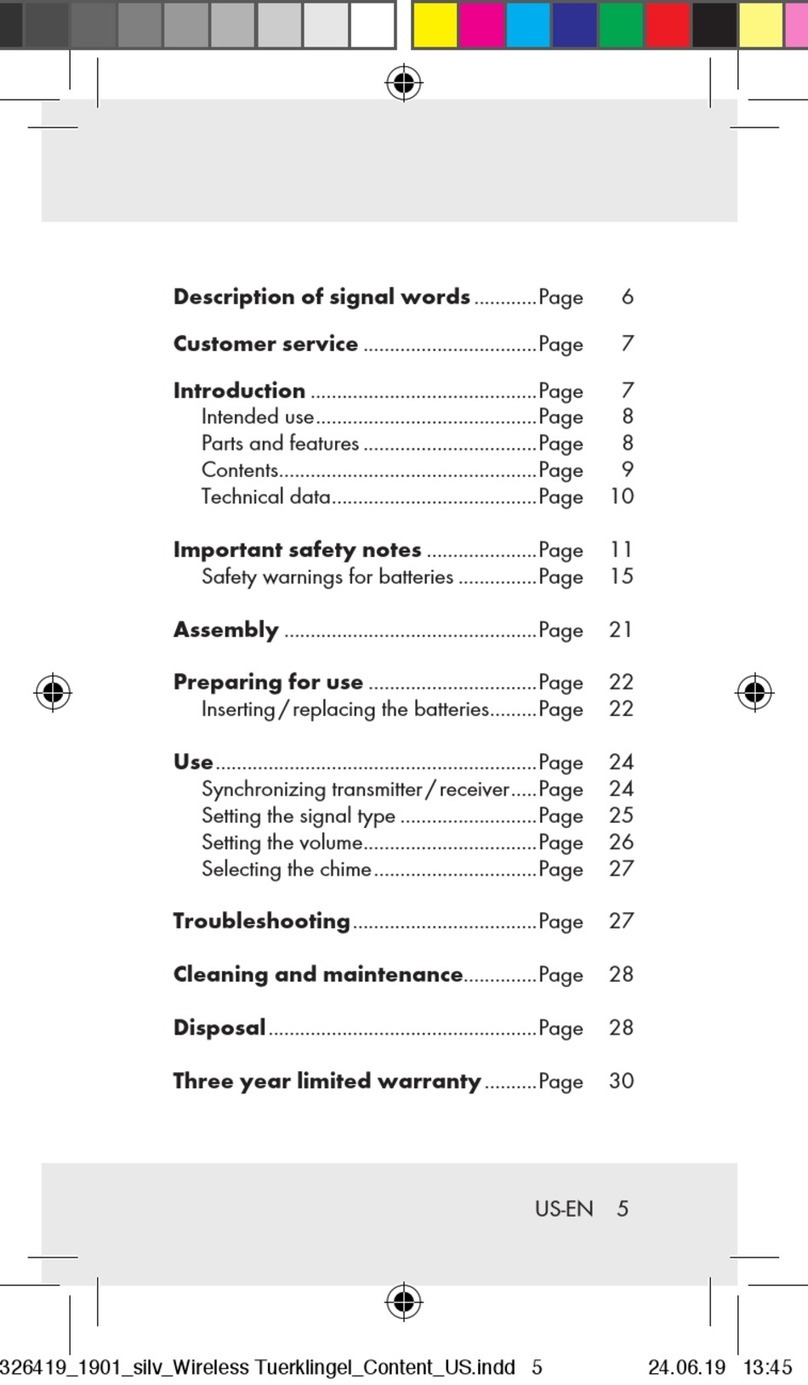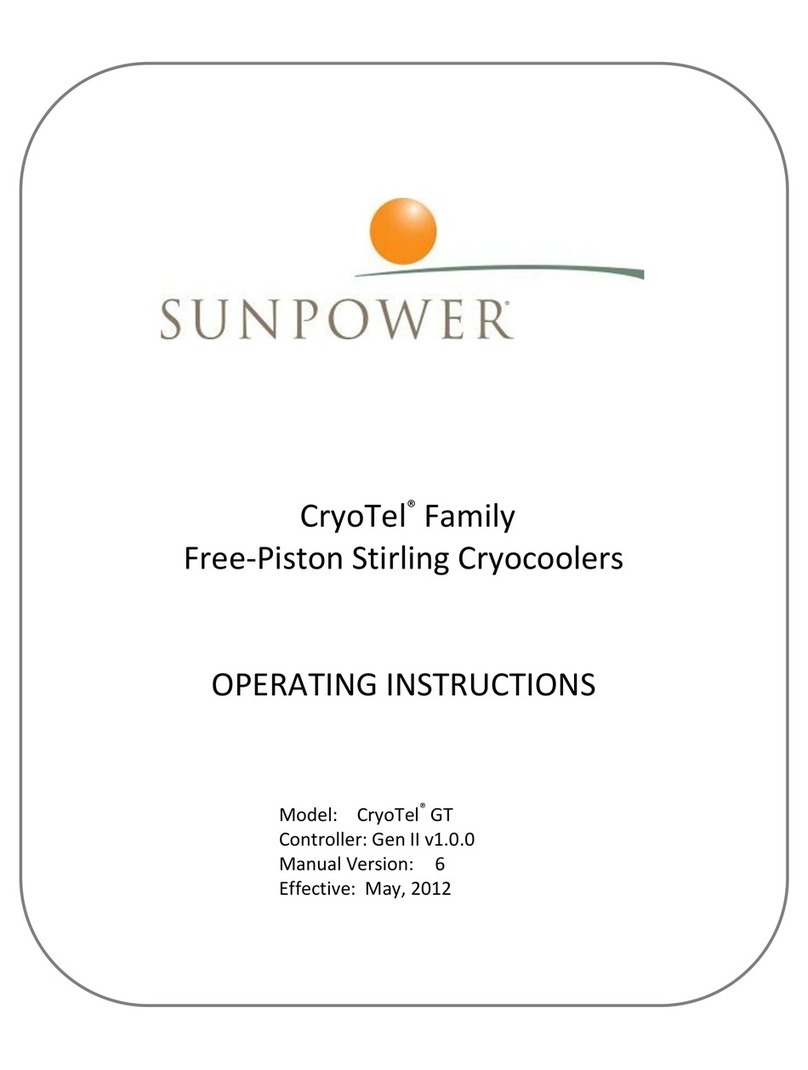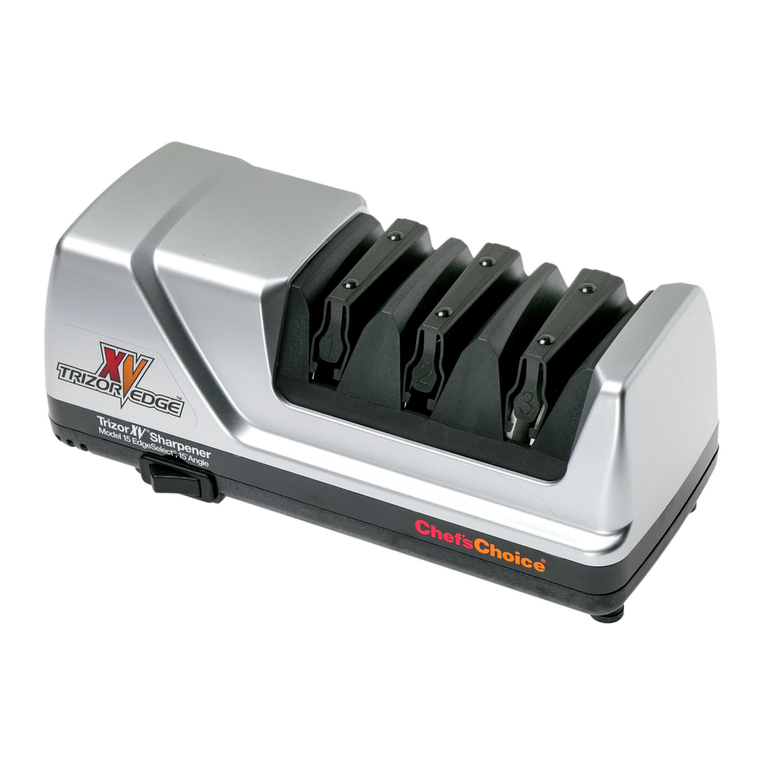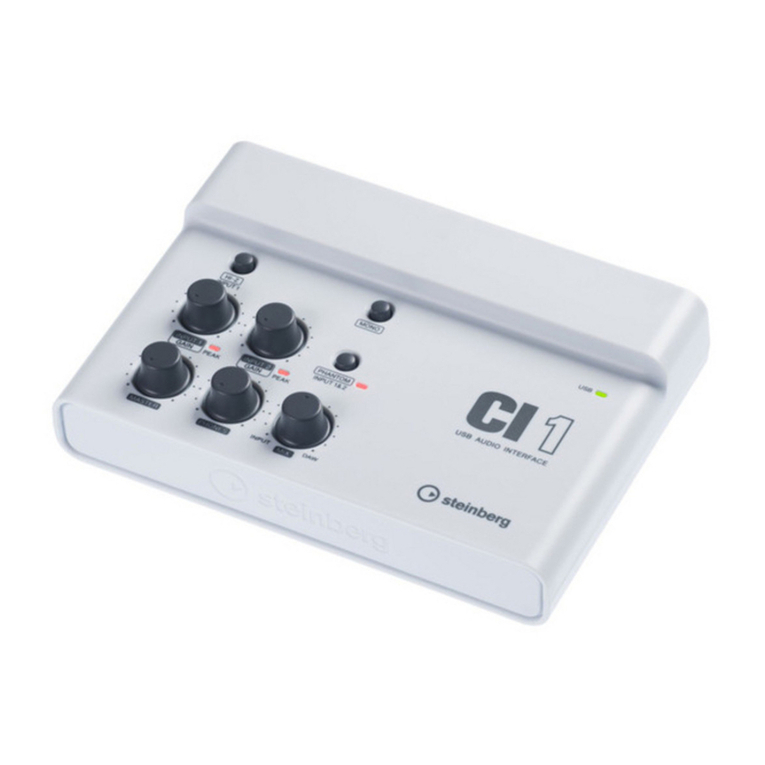Stevens Hydra Probe II Series User manual

Stevens® Water Monitoring System, Inc.
The Hydra Probe®Soil Sensor
Comprehensive
Stevens Hydra Probe
Users Manual
92915 July 2007
1

Safety and Equipment Protection
_____________________________________________________________
WARNING!
ELECTRICAL POWER CAN RESULT IN DEATH, PERSONAL INJURY OR CAN CAUSE
DAMAGE TO EQUIPMENT. If the instrument is driven by an external power source,
disconnect the instrument from that power source before attempting any repairs.
WARNING!
BATTERIES ARE DANGEROUS. IF HANDLED IMPROPERLY, THEY CAN RESULT IN
DEATH, PERSONAL INJURY OR CAN CAUSE DAMAGE TO EQUIPMENT. Batteries can
be hazardous when misused, mishandled, or disposed of improperly. Batteries contain potential
energy, even when partially discharged.
WARNING!
ELECTRICAL SHOCK CAN RESULT IN DEATH OR PERSONAL INJURY. Use extreme
caution when handling cables, connectors, or terminals; they may yield hazardous currents if
inadvertently brought into contact with conductive materials, including water and the human
body.
CAUTION!
Be aware of protective measures against environmentally caused electric current surges. Read
the Stevens Engineering Applications Note, Surge Protection of Electronic Circuits, part
number 42147. In addition to the previous warnings and cautions, the following safety activities
should be carefully observed.
Children and Adolescents.
NEVER give batteries to young people who may not be aware of the hazards associated with
batteries and their improper use or disposal.
Jewelry, Watches, Metal Tags
To avoid severe burns, NEVER wear rings, necklaces, metal watch bands, bracelets, or metal
identification tags near exposed battery terminals.
Heat, Fire
NEVER dispose of batteries in fire or locate them in excessively heated spaces. Observe the
temperature limit listed in the instrument specifications.
Charging
NEVER charge "dry" cells or lithium batteries that are not designed to be charged.
NEVER charge rechargeable batteries at currents higher than recommended ratings.
NEVER recharge a frozen battery. Thaw it completely at room temperature before connecting
charger.
2

Safety and Equipment Protection (Continued)
Unvented Container
NEVER store or charge batteries in a gas-tight container. Doing so may lead to pressure buildup
and explosive concentrations of hydrogen.
Short Circuits
NEVER short circuit batteries. High current flow may cause internal battery heating and/or
explosion.
Damaged Batteries
Personal injury may result from contact with hazardous materials from a damaged or open
battery. NEVER attempt to open a battery enclosure. Wear appropriate protective clothing, and
handle damaged batteries carefully.
Disposal
ALWAYS dispose of batteries in a responsible manner. Observe all applicable federal, state, and
local regulations for disposal of the specific type of battery involved.
NOTICE
Stevens makes no claims as to the immunity of its equipment against lightning strikes, either
direct or nearby.
The following statement is required by the Federal Communications Commission:
WARNING
This equipment generates, uses, and can radiate radio frequency energy and, if not installed in
accordance with the instructions manual, may cause interference to radio communications. It has
been tested and found to comply with the limits for a Class A computing device pursuant to
Subpart J of Part 15 of FCC Rules, which are designed to provide reasonable protection against
such interference when operated in a commercial environment. Operation of this equipment in a
residential area is likely to cause interference in which case the user at his own expense will be
required to take whatever measures may be required to correct the interference.
USER INFORMATION
Stevens makes no warranty as to the information furnished in these instructions and the reader
assumes all risk in the use thereof. No liability is assumed for damages resulting from the use of
these instructions. We reserve the right to make changes to products and/or publications without
prior notice.
3

Comprehensive Stevens Hydra Probe II User's Manual
Table of Contents
1 Introduction 6
1.1 Applications.................................................................................................................................6
1.2 Temperature Corrections .............................................................................................................7
1.3 Calibrations..................................................................................................................................7
1.4 Dielectric Permittivity .................................................................................................................7
1.5 Structural Components ................................................................................................................7
1.6 Accuracy and Precision ...............................................................................................................7
2 Configurations of the Hydra Probe 8
2.1 Digital Probes ..............................................................................................................................8
2.1.1 Addressing & Programming...............................................................................................9
2.1.2 Daisy Chaining Versus Home Run Wiring ........................................................................9
2.1.3 SDI-12 Hydra Probe II .......................................................................................................9
2.1.3.1 Transparent Mode .....................................................................................................9
2.1.4 Digital RS-485 Hydra Probe II.........................................................................................10
2.1.4.1 Addressing and Programming ................................................................................10
2.2 Analog Hydra Probe ..................................................................................................................11
2.2.1 Analog Hydra Probe Output.............................................................................................11
2.3.2 Post possessing raw voltages into the measurements of interest...........................................12
2.2.2 Trouble Shooting the Analog Hydra Probe......................................................................13
2.3 Other Applications and Alternative Calibrations ......................................................................13
2.3.1 Frozen Soil .......................................................................................................................14
3Installation 15
3.1 Avoid Damage to the Hydra Probe:...........................................................................................15
3.1.1 Lightning ..........................................................................................................................15
3.2 Wire Connections ......................................................................................................................15
3.2.1 Analog Probe Wire Connection .......................................................................................15
3.2.2 SDI-12 Hydra Probe Wiring Connections........................................................................16
3.2.3 RS-485 Hydra Probe wiring Connections........................................................................16
3.3 Soil and Topographical Considerations....................................................................................17
3.3.1 Soil Moisture Calibration .................................................................................................17
3.3.2 Soil Classifications...........................................................................................................18
3.4 Installation of the Hydra Probe in Soil ......................................................................................19
3.4.1 Topography and Groundwater Hydrology .......................................................................19
3.4.2 Installation of the Hydra Probe into Soil..........................................................................21
3.4.3 Hydra Probe Depth Selection...........................................................................................22
3.4.4 Back Filling the Hole after the Probes are Installed.........................................................24
4 Measurements, Parameters, and Data Interpretation 26
4.1 Analog Hydra Probe Output ......................................................................................................26
4.1.1 Raw Voltages V1, V2, and V3.......................................................................................26
4.1.2 V4 .....................................................................................................................................26
4.1.3 V5 .....................................................................................................................................26
4.1.4 ADC Reading 1 through 5................................................................................................26
4

4.1.5 Diode Temperature...........................................................................................................26
4.2 Soil Temperature .......................................................................................................................27
4.3 Soil Moisture .............................................................................................................................27
4.3.1 Soil Moisture Units ..........................................................................................................27
4.3.2 Soil Moisture Measurement Considerations ....................................................................28
4.4 Soil Salinity (g/L NaCl).............................................................................................................29
4.5 Soil Electrical Conductivity (Temperature corrected)...............................................................30
5 Theory of Operation 31
5.1 Real and Imaginary Dielectric Constants ..................................................................................31
5.2 Real Dielectric and Imaginary Constants (Temperature corrected) ..........................................33
5.3 Soil Electrical Conductivity.......................................................................................................33
5.3.1 Electrical Conductivity Pathways in Soil.........................................................................33
5.3.2 Solution Chemistry...........................................................................................................34
5.3.3 Cation Exchange and Agriculture – Reclaiming Salt Infested Land................................35
6 Maintenance and Trouble Shooting 37
6.1 How to tell if the Hydra Probe is Defective...............................................................................37
6.1.1 SDI-12 Hydra Probe Trouble shooting commands ..........................................................37
6.2 Check the Wiring.......................................................................................................................38
6.3 Logger Setup..............................................................................................................................38
6.4 Soil Hydrology...........................................................................................................................38
6.4.1 Evapotranspiration ...........................................................................................................39
6.4.2 Hydrology and Soil Texture.............................................................................................39
6.4.3 Soil Bulk Density .............................................................................................................40
6.4.4 Shrink/Swell Clays...........................................................................................................40
6.4.5 Rock and Pebbles .............................................................................................................40
6.4.6 Bioturbation......................................................................................................................41
6.4.7 Salt Affected Soil .............................................................................................................41
5

1 Introduction
The Stevens Hydra Probe Soil Sensor measures soil temperature, soil moisture, soil electrical
conductivity and the complex dielectric permittivity. Designed for many years of service buried
in soil, the Hydra Probe uses quality material in its construction. Marine grade stainless steel,
ABS housing and a high grade epoxy potting protect the internal electrical component from the
corrosive and the reactive properties of soil. Most of the Hydra Probes installed more than a
decade ago are still in service today.
The Hydra Probe is not only a practical measurement device it, is also a scientific instrument.
Trusted by farmers to maximize crop yields, using Hydra Probes in an irrigation system can
prevent runoff that may be harmful to aquatic habitats, conserve water where it is scarce, and
save money on pumping costs. Researchers can rely on the Hydra Probe to provide accurate and
precise data for many years of service. The inter-sensor variability is very low, allowing direct
comparison of data from multiple probes in a soil column or in a watershed.
The Hydra Probe bases it measurements on the physics and behavior of a reflected
electromagnetic radio wave in soil to determine the dielectric permittivity. From the complex
dielectric permittivity, the Hydra Probe can simultaneously measure soil moisture and electrical
conductivity. The complex dielectric permittivity is related to the electrical capacitance and
electrical conductivity. The Hydra Probe uses patented algorithms to convert the signal response
of the standing radio wave into the dielectric permittivity and thus the soil moisture and soil
electrical conductivity.
1.1 Applications
The US Department of Agriculture Soil Climate Analysis Network (SCAN) has depended on the
Hydra Probe in hundreds of stations around the United States and Antarctica since the early
1990s. The Bureau of Reclamation's Agrimet Network, NOAA, and countless other mesonets
and research watersheds around the world trust the measurements the Hydra Probe provides.
Some of the applications include:
Agriculture Irrigation
Viticulture Sports Turf
Research Soil Phytoremediation
Water Shed Modeling Evapotranspiration Studies
Land Reclamation Land Slide Studies
Shrink/Swell Clays Flood Forecasting
Satellite Ground Truthing Wetland Delineation
Predicting Weather Precision Agriculture
6

1.2 Temperature Corrections
The Hydra Probe’s soil moisture and electrical conductivity measurements are temperature
corrected providing temperature independent data year round.
1.3 Calibrations
The Hydra Probe has four calibrations that provide excellent performance in most mineral soils
regardless of texture or organics. The calibrations are sand, silt, clay and loam. The loam soil
calibration is the default calibration and is suitable for Silt Loams, Loam, Clay Loam, Silty Clay
Loam, Sandy Clay Loam, Sandy Loam, and some medium textured clays.
1.4 Dielectric Permittivity
For research studies involving andisol pumas soil, wetland histasol soils or soil with extremely
low bulk densities, the uncorrected and the temperature corrected complex dielectric
permittivities are provided for custom calibrations.
1.5 Structural Components
There are three main structural components to the Hydra Probe. The marine grade stainless steel
tine assembly is the wave guide. The tine assembly is the four metal rods that extend out of the
base plate. Each tine is 45 mm long by 3 mm wide. The base plate is 25 mm in diameter.
Electromagnetic waves at a radio frequency are transmitted and received by the center tine. The
head or body of the probe contains the circuit boards, microprocessors, and all the other
electrical components. The outer casing is ABS and the internal electronics are permanently
potted with a rock-hard epoxy resin giving the probes a rugged construction. The cable has a
direct burial casing and contains the power, ground, and data wires that are all soldered to the
internal electronics.
1.6 Accuracy and Precision
The Hydra Probe provides accurate and precise measurements. Table 1.1 below shows the
accuracy. For a detailed explanation of accuracy and precision and on the statistical evaluation of
the Hydra Probe, see Appendix D.
Parameter Accuracy/Precision
Temperature (C) +/- 0.6 Degrees Celsius(From -30oto 36oC)
Soil Moisture wfv (m3m-3) +/- 0.03 wfv (m3m-3) Accuracy
Soil Moisture wfv (m3m-3) +/- 0.003 wfv (m3m-3) Precision
Electrical Conductivity (S/m) TUC* +/- 0.0014 S/m or +/- 1%
Electrical Conductivity (S/m) TC** +/- 0.0014 S/m or +/- 5%
Real/Imaginary Dielectric Constant TUC* +/- 0.5 or +/- 1%
Real/Imaginary Dielectric Constant TC* +/- 0.5 or +/- 5%
Table 1.1 Accuracy and Precision of the Hydra Probes’ Parameters.
*TUC Temperature uncorrected full scale
**TC Temperature corrected from 0 to 35o C
7

2 Configurations of the Hydra Probe
The Hydra Probe is available in three versions, differentiated by the manner that information is
transferred.
!SDI-12
!RS-485
!Analog
The two digital versions (SDI-12 and RS-485) incorporate a microprocessor to process the
information from the probe into useful data. This data is then transmitted digitally to a receiving
instrument. SDI-12 and RS-485 are two different methods of transmitting digital data. In both
versions there are electrical and protocol specifications that must be observed to ensure reliable
data collection.
The Analog version requires an attached instrument to measure voltages. This information must
then be processed to generate useful information. This can be done either in the attached
instrument, such as a data logger, or at a central data processing facility.
All configurations provide the same measurement parameters with the same accuracy. The under
lying physics behind how the Hydra Probe works, and the outer construction are also the same
for each configuration. Table 2.1 provides a physical description of the Hydra Probe.
Feature Attribute
Probe Length 12.4 cm (4.9 inches)
Diameter 4.2 cm (1.6 inches)
Sensing Volume*
(Cylindrical measurement region)
Length 5.7 cm (2.2 inches)
Diameter 3.0 cm (1.2 inches)
Weight 200g (cable 80 g/m)
Power Requirements 7 to 20 VDC (12 VDC is ideal)
-30 to 65oCTemperature Range
-40 to 70oCStorage Temperature Range
Table 2.1 Physical description of the Hydra Probe (All Versions)
The cylindrical measurement region or sensing volume is the soil that resides between the stainless steel tine
assembly. The tine assembly is often referred to as the wave guide and probe signal averages the soil in the sensing
volume.
2.1 Digital Probes
Digital probes offer some advantages over the Analog version. One is that post-processing of the
data is not required. Another is that the data is not affected by the length of the cable. Analog
probes, since their information is delivered as voltage, should only be used with relatively short
cables, on the order of 8 meters (25 feet). Digital cables can be much longer. SDI-12 cables can
be up to 50 meters long (150 feet), and RS-485 cables can be up to 1000 meters (3000 feet).
Digital probes can also be used with short cables without any trouble. Some installations use
cables that are less than a meter (three feet) long.
8

2.1.1 Addressing & Programming
The digital versions of the Hydra Probe (the SDI-12 and RS-485 versions) can be connected in
parallel so that multiple probes can be connected to a single communications port of a data
logger or other device. When multiple probes are connected this way, each probe must be
assigned a unique address before they are installed. The methods used for both probes are
similar, but unique. In addition, the user can select which processing method for the probe to use
and select which data is to be transmitted.
2.1.2 Daisy Chaining Versus Home Run Wiring
If you are contemplating the installation of multiple probes over a large area, consideration
should be given to the physical layout of the cables. Digital probes can be connected in a “Daisy
Chain” manner, where each probe is spliced onto the cable of the previous probe. This can
reduce the amount of cable required along with the corresponding cost. However, this means that
splices with have to made, and will likely need to be done in the field. Further if a cable breaks
or a splice fails, all probes beyond that point will be out of service until the break is repaired.
“Home Run” wiring means that each probe has a dedicated cable that runs all the way back to the
data collection station. The advantages here are just the reverse of “Daisy Chaining”. If there is a
break in the cable, only that probe is affected. There are no splices to fail. The disadvantage is
that the cable requirements and associated costs will be higher.
2.1.3 SDI-12 Hydra Probe II
The SDI-12 version is digital and can be used with Data Loggers that support this
communications method. SDI-12 stands for Serial Data Interface at 1200 baud. SDI-12 was
developed in cooperation with the USGS (U.S. Geological Survey) and is a standard
communication protocol for environmental sensors and data loggers.
2.1.3.1 Transparent Mode
Transparent Mode allows the user to communicate directly with the Hydra Probe. This is
necessary in order to assign an address to the probe or modify the probe's configuration.
To program an SDI-12 Version of the Hydra Probe, an SDI-12 compatible device that supports
Transparent Mode is required. Most SDI-12 data loggers support Transparent Mode. The SDI-12
protocol is not compatible with common serial data communications, so a device is needed to
convert between the two. A typical method is to connect a Personal Computer (PC) to a data
logger using a standard nine pin serial data communications cable, and then the probe is
connected to the SDI-12 port on the logger, and power is supplied. A terminal program (like
Hyper Terminal) is started on the PC. Typically the user must issue a command to the logger to
enter Transparent Mode.
See Appendix A for specific information on SDI-12 commands for the Hydra Probe. Please visit
www.SDI-12.org for more information about the SDI-12 Protocol. Table 2.2 describes the
physical specifications, wire designations, and other information about the digital SDI-12 Hydra
Probe II.
9

Power Requirements 9 to 20 VDC (12VDC Ideal)
Red Wire +Volts Power Input
Black Wire Ground
Blue Wire SDI-12 Data Signal
Baud Rate 1200
Power Consumption <1 mA Idle, 30 mA Active
Table 2.2 Digital SDI-12 Hydra Probe II Information.
2.1.4 Digital RS-485 Hydra Probe II
Like the SDI-12 Hydra Probe, the RS-485 probe is also digital. The RS-485 communication
format has 2 data wires, consumes more power when idle and has a custom communication
protocol. Being digital, the RS-485 version shares many of the benefits the SDI-12 version does.
The RS-485 sensors can be “daisy chained” or wired to a terminal assembly to simplify
installation. The RS-485 Hydra Probe has a maximum cable length of 1000 meters. The user
may have specific applications where this capability is advantageous, however, due to the cost of
the cable, it may be more cost effective to run short cables and have additional data loggers. See
appendix B for more information about commands for the RS-485 Hydra Probe.
Power Requirements 9 to 20 VDC (12VDC Ideal)
Red Wire +Volts Power Input
Black Wire Ground
White Wire Data Signal A non-inverting signal
Green Wire Data Signal B inverting signal
Baud Rate 9600 8N1
Power Consumption <10 mA Idle 30 mA Active
Table 2.3 Digital RS-485 Hydra Probe II Information.
2.1.4.1 Addressing and Programming
RS-485 data communications ports are not commonly found on Personal Computers (PC's). To
prepare an RS-485 version of the Hydra Probe it will be necessary to program the address. One
method to talk to the probe is to connect the probe to a PC via an “RS-485 to RS-232 converter”.
These devices are available from several vendors specializing in data communications products.
Once the probe is connected and power is applied, a terminal emulation program, such as Hyper
Terminal is started on the PC. Certain settings will be need to be set to enable communications
with the probe. The following settings are for Hyper Terminal, but most terminal emulation
programs should have equivalent settings.
!COM Port should be set to correspond with actual port on the PC where the
communications cable is plugged in. For instance COM1, COM2, etc.
!Baud rate should be set to 9600
!Data bits should be set to 8
!Parity should be set to none.
!Stop bits should be set to 1 (one).
10

!Flow control should be set to none.
In addition, these setting will make the program easier to use. In Hyper Terminal these settings
are found under File / Properties / Settings / ASCII Setup / ACSII Sending:
!Check “Send line ends with line feeds”. All commands sent to an RS-485
version of the Hydra Probe must end with a “Carriage Return” “Line Feed” pair.
!Check “Echo typed characters locally”. The Hydra Probe does not echo any
commands. Checking this enables you to see what you have typed.
2.2 Analog Hydra Probe
The Analog Hydra Probe was the first version made available. The Analog version is useful for a
number of applications. Current customers of the Analog probe include users that need to replace
or add a sensor to an existing system that was specifically tailored for the analog sensors. One
advantage the Analog Hydra Probe has over the digital version is the fast measurement rate. For
example, on the beach, ocean researchers can use the analog Hydra Probe to measure the
hydrology of sands in the surf zone where they would want to take several measurements
between waves. This would entail taking measurements several times per second, something the
digital probes cannot do.
2.2.1 Analog Hydra Probe Output
The output of the Analog Hydra Probe is 4 voltages. These four voltages are the raw signal
response of the measurement and directly represent the behavior of the reflected electromagnetic
standing wave. The four voltages need to be processed by a computer program in order to obtain
the parameters of interest such as soil temperature, soil moisture, soil electrical conductivity and
the dielectric constants.
Table 2.4 below shows the wiring scheme.
Black Wire Ground
Red Wire Power 7 to 30 VDC (12 VDC Ideal)
Blue Wire (Output) V1 (Raw Voltage 1) Range 0-2.5 volts
Brown Wire (Output) V2 (Raw Voltage 2) Range 0-2.5 volts
Green Wire (Output) V3 (Raw Voltage 3) Range 0-2.5 volts
White Wire (Output) V4 (Raw Voltage 4) Range 0-1 volts
Yellow Wire Reference Ground
Power Draw Active 35 to 40 mA
Table 2.4 wiring scheme for the Analog Hydra Probe.
An easy way to remember the wiring scheme is the colors of the wires are ordered
alphabetically. The black and yellow ground wires may be connected and grounded together or
grounded separately. The four voltage data wires need to be wired into four separate voltage
sensing connection points on the recording instrument. On the Stevens DOT Logger, the analog
ports are labeled A1, A2, A3, and A4. Use the logger data acquisition procedure to obtain the
raw voltages values. For more information about the Stevens Dot Logger, see appendix C.
11

2.3.2 Post possessing raw voltages into the measurements of interest.
The output of the Analog Hydra Probe is 4 voltages, each on a separate color coded wires. V1
V2 and V3 will be between 0 and 2.5 volts DC. V4 will be between 0.1 to 0.8 volts DC. These 4
voltages need to be processed by a series of algorithms to obtain the parameters of interest.
Stevens provides two executable programs to perform these calculations:
!HYDRA.EXE
!HYD_FILE.EXE.
HYD_FILE.EXE and HYDRA.EXE as well as the instruction procedure for HYD_FILE.EXE
can be downloaded from the Stevens website at: http://www.stevenswater.com
HYD_FILE.EXE is the program used for processing tables of raw voltages collected over time.
HYDRA.EXE is the program used for a single measurement of the 4 voltages.
FIG. 2.1 HYDRA.EXE Input V1, V2, V3, V4 and Output Parameters.
To use HYDRA.EXE simply open the file and follow the prompts. The first prompt will ask
“Type A Probe ? (Y/N):”. Type Y. Almost all of the Analog Hydra Probes are type A.
Type A probes use a 2.5 volt reference for the temperature sensing element. A non-type A probe
uses a 5 volt reference. Next, enter the soil type and then the four voltage values. After the user
12

responds to all of the prompts, the output is displayed. The displayed output consists of the
dielectric constants, the temperature, the soil moisture, and the soil electrical conductivity.
2.2.2 Trouble Shooting the Analog Hydra Probe
If the Hydra Probe appears to be malfunctioning, there are three likely causes:
!communication with the logger
!soil hydrology
!a malfunctioning probe.
See the section about soil hydrology.
Programming a data logger is not a trivial task. The data logger needs to extract 4 raw voltages
from four analog ports on the logger with the desired timing interval. If the user is unable to get a
response from the Hydra Probe, it is recommended to first physically check wire connections
from the probe to the logger. The user may also want to cycle the power to the probe by
disconnecting and reconnecting both ground wires. If the connections are sound, the user will
next need to check the logger’s setup. Are the data ports enabled? Are the data ports scaled
properly in the appropriate units? Are the probes and logger adequately powered? Is the data
properly recorded on the logger? If the logger has GUI based operation software, there may be
a help function. If the logger only accepts terminal command scripts in a terminal window, refer
to the logger’s manual or manufacturer. Also, make sure the computer is properly connected to
the logger. Is the computer on the proper COM port? What about the Baud rate? Does the
logger need a NUL modem or optical isolator in order to be connected to a computer? Most of
the technical support questions Stevens receives are not due to malfunctioning probes but rather
an incorrect data logger setup.
A good way to verify if the probe is working properly is to submerge the probe in distilled
water* in a plastic container and check the real dielectric permittivity. Once the probe is
submerged, connect the black and yellow wires to a ground and connect the red wire to a +12
volt DC power source. Use a voltmeter to measure the raw voltage on the 4 data wires. A
common hand held unit is adequate. Use HYDRA.EXE to process the voltages. The temperature
corrected real dielectric permittivity should be 75 to 85 and the imaginary dielectric permittivity
should be less than 5. The user may use this method to verify if the probe is functioning
properly, and to verify the logger output. If the probe is buried in the soil, the user can obtain the
4 raw voltage outputs with a multimeter and compare them to the logger’s output.
*The user may also use tap water for this procedure, however, it is important to note that tap water contains
dissolved material and trace contaminants that might affect the dielectric constants.
2.3 Other Applications and Alternative Calibrations
It may be possible to use the Hydra Probe for applications in media other than mineral soil. Some
examples include peat, decomposed plant material, grain, compost, ice cream/ food products or
any material that has a small real dielectric permittivity compared to that of water. The
calibration curves used to calculate soil moisture may not be valid for material different from
mineral soil; however, the complex dielectric permittivity is provided allowing the user to
13

calibrate the probe accordingly. The calibration curves will mathematically have the appearance
of equation [2.1] or [2.2]
θ= A + BEr+ CEr
2 +DEr
3 [2.1]
θ= AEr
1/2 + B [2.2]
Where θis moisture Er is the real dielectric permittivity and A,B,C, and D are coefficients. If
the user wishes to use the Hydra Probe to measure moisture in a matrix that is not mineral soil,
the user must empirically and experimentally solve equation [2.1] or equation [2.2]. Also, The
user should review the matrix compatibility requirements of the probe in section 3.1.
2.3.1 Frozen Soil
The Hydra Probe can also be used to determine if soil is frozen. Once ice reaches 0oCelsius, it
will begin to thaw and the real dielectric permittivity will increase from 5. The temperature alone
may not indicate whether or not the soil is frozen. As the soil begins to thaw, the soil moisture
and the real dielectric permittivity should return to values similar to what they were before the
soil froze.
14

3 Installation
The Hydra Probe is easy to install and the use of installation tools are seldom required.
3.1 Avoid Damage to the Hydra Probe:
!Do not subject the probe to extreme heat over 70 degrees Celsius (160 degrees
Farenheit).
!Do not subject the probe to fluids with a pH less than 4.
!Do not subject the probe to strong oxidizers like bleach, or strong reducing agents.
!Do not subject the probe to polar solvents such as acetone.
!Do not subject the probe to chlorinated solvents such as dichloromethane.
!Do not subject the probe to strong magnetic fields.
!Do not use excessive force to drive the probe into the soil because the tines could bend. If
the probe has difficulty going into the soil due to rocks, simply relocate the probe to an
area slightly adjacent.
!Do not remove the Hydra Probe from the soil by pulling on the cable.
While the direct burial cable is very durable, it is susceptible to abrasion and cuts by shovels.
The user should use extra caution not to damage the cable or probe if the probe needs to be
excavated for relocation.
Do not place the probes in a places where they could get run over by tractors or other farm
equipment. The Hydra Probe may be sturdy enough to survive getting run over by a tractor if it is
buried; however, the compaction of the soil column from the weight of the vehicle will affect the
hydrology and thus the soil moisture data.
DO NOT place more than one probe in a bucket of wet sand while logging data. More than one
Hydra Probe in the same bucket while powered may create an electrolysis affect that may
damage the probe.
3.1.1 Lightning
Lightning strikes will cause damage or failure to the Hydra Probe or any other electrical device,
even though it is buried. In areas prone to lightning, serge protection and /or base station
grounding is recommended.
For maximum protection from lightning, attached a duel dissipater to the top of the lightning rod
3 to 6 meters above the ground surface. Using at least a 1 cm thick copper cable, connect the
dissipater to a buried copper rod 2 cm in diameter. The buried copper rod should be at least 3
meters long buried horizontally 1.5 to 3 meters deep.
3.2 Wire Connections
3.2.1 Analog Probe Wire Connection
Table 2.4 in section 2.4.3 shows the wiring scheme for the Analog Hydra Probe. The four
voltage data wires need to be wired into four separate data ports on the logger. On the Stevens
DOT Logger, the analog ports are labeled A1, A2, A3, and A4. The red power wire should be
15

connected to a +12 volt power supply and the black and yellow wires should be connected to a
ground. For more information, refer to the data loggers operation manual. For DOTSET and the
Stevens DOT Logger refer to Appendix C.
3.2.2 SDI-12 Hydra Probe Wiring Connections
Table 2.2 and section 2.1 provide important information about the SDI-12 Hydra Probe. Connect
the red wire to a +12 volt DC power supply, connect the black wire to a ground, and connect the
blue wire to the SDI-12 port or the Data Logger. The SDI-12 data port on the Stevens DOT
logger is conveniently located on the right side of front face plate. The advantage of SDI-12
communications is that multiple probes can be connected to a single port on data logger. The
probes may be “daisy chained” together, or they may all be connected to a central terminal
assembly. The single SDI-12 data port on the DOT Logger can accommodate 150 SDI-12
Channels. To have 150 SDI-12 channels means that 50 probes set to measure soil moisture,
conductivity and temperature can all be wired together on a multiplexer with a single data wire
going into the single SDI-12 data port. For more information, refer to the data loggers operation
manual. For more information about the Stevens DOT Logger refer to Appendix C.
For more than 6 Hydra Probes, the user may find it easier to have the terminal assembly in a
separate enclosure from the logger, telemetry and power supply.
3.2.3 RS-485 Hydra Probe wiring Connections
Table 3.1 and section 2.1.4 provide important information about the RS-484 Hydra Probe.
Connect the red wire to a +12 volt DC power supply, and connect the black wire to a ground.
The green and white wires are the data wires.
Power Requirements 9 to 20 VDC (12VDC Ideal)
Red Wire +Volts Power Input
Black Wire Ground
White Wire Data Signal A non-inverting signal
Green Wire Data Signal B inverting signal
Baud Rate 9600
Power Consumption <10 mA Idle 30 mA Active
Control system settings 8 DATA BITS
Control system settings One Stop Bit
Control system settings NO Parity
Table 3.1 Digital RS-485 Hydra Probe II Information.
Like SDI-12, the RS-485 communication format is also digital, therefore the probes’ data wires
can be “daisy chained” or connected together at a terminal assembly. See Appendix B for
RS-485 command structure.
16

3.3 Soil and Topographical Considerations
3.3.1 Soil Moisture Calibration
There are four calibration curves depending on the texture of the soil. The calibrations curves are
polynomials that include the real dielectric permittivity and several coefficients (Topp 1980,
Seyfried and Murdock 2004). The four user selectable soil texture settings are Sand, Silt, Clay,
and Loam. The texture is determined by the percentage of sand silt and clay there is in the soil.
Figure 3.1 shows the corresponding percentages to the different textures. If you are unsure of
your soil texture, determining which soil setting that is best for your soil is easy and there are a
number of different ways to make the determination (Birkeland 1999).
a) A detailed soil survey for your area can be downloaded for free from the US Department of
Agriculture at http://soildatamart.nrcs.usda.gov/
b) Many times, it will be obvious. Sand looks different from clay.
c) Grab a baseball size portion of the soil in your hands. Wet the soil with water and work the
moist soil with your hands. The stickier it is, the more clay there is. The “soapier” the soil
feels the higher the silt content. Grittiness is indicative of sand.
Figure 3.1 Soil Texture Triangle
17

If you have a mixture of sand, silt and clay or if you are unsure what the texture of your soil is,
then use the Loam setting. The Sand, Silt and Clay settings are only suitable for soils that are
comprised almost entirely of that one material. For most mixtures the Loam setting will give
better results. The Loam setting is applicable for Loam, Clay Loam, Silty Clay Loam, Silt Loam,
Sandy Loam, Sandy Clay Loam, Sandy Clay and Silty Clay textures.
If unsure as which calibration to use, the loam calibration will accommodate most soils. The
Loam calibration is the default calibration, which means, the Hydra Probe is preset to the loam
soil type setting when it leaves the factory. Figure 3.2 shows the textures where the loam setting
works best.
Figure 3.2 The shaded circle in the soil texture triangle is the region where the Loam soil calibration works
best. Most users should use the loam calibration. The Hydra Probe is preset to use the loam soil calibration
when shipped.
3.3.2 Soil Classifications
Between the four preset calibrations and the custom calibration option, the Hydra Probe can
measure soil moisture in almost any kind of soil. There are thousands of different kinds of soil
through out the world, and almost every nation has some kind of classification system. The most
wide spread and most current soil classification system is the Orders of American Soil
18

Taxonomy. In this system, all of the worlds’ soils are broken into 12 orders based on climate,
topography, biology and soil chemistry. Table 3.2 lists the orders.
The Hydra Probe can accommodate all of the soil orders. Andisols, gelisols and histosols are
soil that may have soil moistures and properties that depart from the Hydra Probe’s built in
calibration curves. If the bulk density is extremely low giving the soil an effective porosity
greater than 0.5, the user will need a custom calibration If a custom calibration is required see
Section 2.3. If the Hydra Probe needs to be switched from the default Loam calibration setting,
see the RS-485 or SDI-12 command sections in the appendix.
Soil
Order
Climate or Regime Soil Characteristics Hydra Probe
Calibration
Entisol Sandy Young Soil Stream Flood Plain Sand
Inceptisol Silty Young Soil Evidence of red color Sand or Silt
Vertisol Shrink/Swell Clay Homogenized, Cracks Loam or Clay
Histosol Wetland Soil Anoxic Reduced State Loam or Custom
Aridisol Desert Soil Higher pH Sand
Mollisol Grass land Soil Higher pH Loam or Silt
Spodosol Needle Leaf Forest Soil Low pH Loam or Silt
Alfisol Forest Soil Low pH Loam or Silt
Ultisol Old Forest Soil Low pH Loam
Oxisol Ancient Forest Soil Red, Oxidized Loam
Gelisol Soil With Permafrost Organic Rich Loam or Custom
Andisol Volcanic Ash Soil Low Density Loam or Custom
Table 3.2 The 12 Orders of Soil Taxonomy, Characteristics and Hydra Probe Calibration setting.
3.4 Installation of the Hydra Probe in Soil
3.4.1 Topography and Groundwater Hydrology
The land topography often dictates the soil hydrology. Depending on the users’ interest, the
placement of the Hydra Probe should represent what would be most useful. For example, a
watershed researcher may want to use the Hydra Probe to study a micro climate or small
hydrological anomaly. On the other hand, a farmer will want to take measurements in an area the
best represents the condition of the crops as a whole.
Other factors to consider would be tree canopy, slope, surface water bodies, and geology. Tree
canopy may affect the influx of precipitation/irrigation. Upper slopes may be better drained than
depressions. There may be a shallow water table near a creek or lake. Hill sides may have seeps
or springs.
19

Figure 3.3 Groundwater pathways and Surface water. Taken from USGS Report 00-4008
Figure 3.4 Groundwater flow direction and surface water body. Taken from USGS report 00-4008.
Figures 3.3 and 3.4 illustrate subsurface water movement in the water table. The Hydra Probe
data is most meaningful in the unsaturated zone where soil moisture values will fluctuate. If the
water table rises to the depth of the Hydra Probe, the Hydra Probe soil moisture measurements
will be at saturation and will be indicative of the effective porosity. If the user is interested in
groundwater level measurements in wells, a water depth sensor might provide the necessary
information.
20
Table of contents
Other Stevens Accessories manuals
